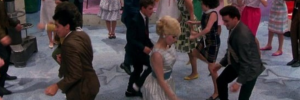Works
Flow 2016: Podcasts and Convergent Digital Media
As part of the tenth anniversary celebration of the landmark open-access media studies publication Flow, I took part in a roundtable discussion titled “Podcasts and Convergent Digital Media” at the Flow Conference in 2016.
“Hairspray and History”: Film 101 Screening Series at the Ambler Theater
As part of the Ambler Theater’s “Film 101” summer screening series, I gave a brief introduction of the cult classic…
“All Culture is Appropriated”: Arcadia University English Language Institute
A lecture about popular culture and “cultural appropriation” for visiting students from DaeJin University in South Korea specializing in American Studies.
Tinsel and Rust
Tinsel and Rust is an academic monograph about Hollywood’s role in the making (and the re-making) of the American Rust Belt.
Book Review – Jim Jarmusch: Music, Words, and Noise
A review of Sara Piazza’s book, Jim Jarmusch: Music, Words, and Noise published in The Historical Journal of Film, Radio and Television.
SCMS 16: Something On the Air
This presentation, delivered at SCMS ’16, argued for the necessity of film and media scholars to consider the industrial processes of pop music distribution (like radio formats) when considering the ways that music becomes culturally meaningful.
OUPBlog: Prince & ‘The Other Eighties’
For people left out of the 1980s neoconservative vision of what America should be, he was a beacon, guiding us through this thing called life.
For the Women SPEAK OUT: “On ‘Nice Guy’ Misogyny”
In April 2013, Rose Elyse Coyne of Arcadia University’s student group For the Women invited me to participate in…
Memory, Mourning, and Michael: Jiangsu University, China
This lecture, delivered to the faculty of the School of Foreign Languages at Jiangsu University in China, centered on the use of Fifties style and imagery in the 1980s music videos of Michael Jackson.
IAMHIST 2015
This presentation, delivered to the International Association of Media and History, provided a cultural history of Oldies, as a term, radio format, and genre.
SCMS 15: Soul in the Rear View Mirror
This presentation, which centers on the 1980s film THE BLUES BROTHERS, attempted to place its revival of blues music into the historical and cultural context of the Reagan Era.
Film & History 2014: The ‘New Man’ and Fifties Stardom
This presentation, delivered at the Film and History Conference, was focused on the transformation of James Dean’s star text in popular culture of the 1970s and 1980s.
“That’s Entertainment!” Symposium: “MJ and ‘Real Showmen'”
Michael Jackson experienced resistance from powerful institutions in pop music before his blockbuster 1982 solo album Thriller, and skepticism from some influential Black cultural figures after it. In both cases Jackson partially addressed these challenges through nostalgia-inducing images of the Fifties in his music videos.
Book – Back to the Fifties
Back to the Fifties, published in 2015 by Oxford University Press, is the first sustained academic analysis of fifties nostalgia in American popular culture in the 1970s and 1980s. The central focus of the manuscript is the political, cultural, and social functions of “the fifties,” a concept nostalgically constructed and reconstructed in the years 1973-1988.
Alphaville: “The Same Old Songs”
This article, published in Issue #3 of the peer-reviewed open-access journal Alphaville, examines the recontextualization of 1950s rock in the form of “Oldies” in teen films of the 1970s and 1980s.
“Fixing the Fifties”
The chapter, published in the Rowman & Littlefield collection The 1980s: A Critical and Transitional Decade, looks at both Reagan’s political speeches and pop culture texts from the period (Back to the Future and Family Ties) in an attempt to understand the implications of political and cultural mobilizations of nostalgia in the 1980s.
“It Was Something…”: Sadie Benning, Kathleen Hanna, and the Limits of Grrrl-hood
This essay, published in the collection _Singing for Themselves_, works backwards from the collusion of Benning and Hanna in Le Tigre to trace the connections between Sadie Benning’s celebrated video art and the music of Hanna’s Bikini Kill.
“A Pure Object, A Spectacle, A Clown…”
“A pure object, a spectacle, a clown…” was a companion to performance artist Neal Medlyn’s show “Wicked Clown Love,” and discusses the relation of Roland Barthes’ Mythologies to the fan culture surrounding horror-rap group Insane Clown Posse.
Raphael Saadiq’s Soul Memory
In Summer 2012 I curated a discussion on the open-access scholarly forum In Media Res as a part of their Theme Week on “Media Memories.” In this post, I explain the distinction between retro, as an aesthetic or representational style, and nostalgia, an affective response to contemporary historical and political conditions.
“The Gathering of the Juggalos and the Peculiar Sanctity of Fandom”
This article, submitted to a special issue on what media studies scholars term “Aca-Fandom,” centered on the tendency of recent media studies scholarship to inherently respect fan practices, despite the very real existence of fan practices that engage in symbolic and even material violence.
Negative Dunkalectics & “On Windows Closing”
In 2011 I joined the staff of Negative Dunkalectics, an often tongue-in-cheek look at the cultural and aesthetic world of NBA basketball.
The Re-Decade
Designed as a companion site and promotional vehicle for my book manuscript, I started The-Re-Decade on popular microblogging site Tumblr in late 2012.
SCMS 2013: “The Meaning of the Word Neighbor in Rear Window”
Viewing 1950s records of the New York City Planning Commission and comparing them to the critiques brought forth in Jane Jacobs’ The Death and Life of Great American Cities (1961), this paper will explore the specific historical and spatial representations of urban space in Rear Window, one of film studies’ most important texts.
THATCamp Philly
THATCamp, The Humanities And Technology Camp, is a free, open, interdisciplinary “unconference” where humanists and technologists meet to work together for the common good.
SCMS 2012: “Old Time Rock and Roll”
This presentation examined Reagan Era films that utilized 1950s popular music on their soundtracks to critique or undermine the commodification and depoliticization of Oldies. This, I argued, serves as just one illustration of the complexity and diversity of uses for nostalgia in the 1980s, outside and against the dominant “Reagan Era” narratives that so easily come to mind.
PCMS: “Re-Reading American Graffiti”
In the 1980s, nostalgia for the fifties became an enormously lucrative and politically resonant trope in American popular culture. The text most often identified as the founding document of this “nostalgia wave” in America is American Graffiti (1973).
SCMS 2011: “The Same Old Songs?”
This paper was delivered as part of a panel called “Hollywood on the Air” at the 2011 Society of Cinema…






































